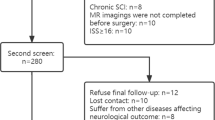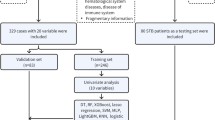Abstract
Due to the diversity of patient characteristics, therapeutic approaches, and radiological findings, it can be challenging to predict outcomes based on neurological consequences accurately within cervical spinal cord injury (SCI) entities and based on machine learning (ML) technique. Accurate neurological outcomes prediction in the patients suffering with cervical spinal cord injury is challenging due to heterogeneity existing in patient characteristics and treatment strategies. Machine learning algorithms are proven technology for achieving greater prediction outcomes. Thus, the research employed machine learning model through extreme gradient boosting (XGBoost) for attaining superior accuracy and reliability followed with other MI algorithms for predicting the neurological outcomes. Besides, it generated a model of a data-driven approach with extreme gradient boosting to enhance fault detection techniques (XGBoost) efficiency rate. To forecast improvements within functionalities of neurological systems, the status has been monitored through motor position (ASIA [American Spinal Injury Association] Impairment Scale [AIS] D and E) followed by the method of prediction employing XGBoost, combined with decision tree for regression logistics. Thus, with the proposed XGBoost approach, the enhanced accuracy in reaching the outcome is 81.1%, and from other models such as decision tree (80%) and logistic regression (82%), in predicting outcomes of neurological improvements within cervical SCI patients. Considering the AUC, the XGBoost and decision tree valued with 0.867 and 0.787, whereas logistic regression showed 0.877. Therefore, the application of XGBoost for accurate prediction and decision-making in the categorization of pre-treatment in patients with cervical SCI has reached better development with this study.






Similar content being viewed by others
Data availability
Not applicable.
Code availability
Not applicable.
Change history
10 May 2024
This article has been retracted. Please see the Retraction Notice for more detail: https://doi.org/10.1007/s00586-024-08294-7
References
Michaud F (2020) Neuromusculoskeletal human multibody models for the gait of healthy and spinal-cord-injured subjects (Doctoral dissertation, Universidade da Coruña)
Liu L, Yu Y, Fei Z, Li M, Wu FX, Li HD, Pan Y, Wang J (2018) An interpretable boosting model to predict side effects of analgesics for osteoarthritis. BMC Syst Biol 12:105
Chen T, Guestrin C (2016) XGBoost: a scalable tree boosting system. arXiv (2016), 1–6. arXiv preprint arXiv:1603.02754
Chakraborty D, Elzarka H (2019) Early detection of faults in HVAC systems using an XGBoost model with a dynamic threshold. Energy Build 185:326–344
Alajali W, Zhou W, Wen S, Wang Y (2018) Intersection traffic prediction using decision tree models. Symmetry 10:386
Deyo RA, Cherkin DC, Ciol MA (1992) Adapting a clinical comorbidity index for use with ICD-9-CM administrative databases. J Clin Epidemiol 45:613–619
Charlson ME, Pompei P, Ales KL, MacKenzie CR (1987) A new method of classifying prognostic comorbidity in longitudinal studies: development and validation. J Chronic Dis 40:373–383
Talbott JF, Whetstone WD, Readdy WJ, Ferguson AR, Bresnahan JC, Saigal R, Hawryluk GW, Beattie MS, Mabray MC, Pan JZ, Manley GT, Dhall SS (2015) The brain and spinal injury center score: a novel, simple, and reproducible method for assessing the severity of acute cervical spinal cord injury with axial T2-weighted MRI findings. J Neurosurg Spine 23:495–504
Bozzo A, Marcoux J, Radhakrishna M, Pelletier J, Goulet B (2011) The role of magnetic resonance imaging in the management of acute spinal cord injury. J Neurotrauma 28:1401–1411
Furlan JC, Noonan V, Cadotte DW, Fehlings MG (2011) Timing of decompressive surgery of spinal cord after traumatic spinal cord injury: an evidence-based examination of pre-clinical and clinical studies. J Neurotrauma 28:1371–1399
Jug M, Kejzar N, Vesel M, Al Mawed S, Dobravec M, Herman S, Bajrovic´, F.F. (2015) Neurological recovery after traumatic cervical spinal cord injury is superior if surgical decompression and instrumented fusion are performed within 8 hours versus 8 to 24 hours after injury: a single center experience. J Neurotrauma 32:1385–1392
Liu J-M, Long X-H, Zhou Y, Peng H-W, Liu Z-L, Huang S-H (2016) Is urgent decompression superior to delayed surgery for traumatic spinal cord injury? A meta-Anal World Neurosurg 87:124–131
Alexander MS, Anderson KD, Biering-Sorensen F, Blight AR, Brannon R, Bryce T, Creasey G, Catz A, Curt A, Donovan W (2009) Outcome measures in spinal cord injury: recent assessments and recommendations for future directions. Spinal Cord 47:582–591
Nusinovici S, Tham YC, Yan MYC, Ting DSW, Li J, Sabanayagam C, Wong TY, Cheng C-Y (2020) Logistic regression was as good as machine learning for predicting major chronic diseases. J Clin Epidemiol 122:56–69
Yokobori S, Zhang Z, Moghieb A, Mondello S, Gajavelli S, Dietrich WD, Bramlett H, Hayes RL, Wang M, Wang KK, Bullock MR (2015) Acute diagnostic biomarkers for spinal cord injury: review of the literature and preliminary research report. World Neurosurg 83:867–878
Noonan VK, Fingas M, Farry A, Baxter D, Singh A, Fehlings MG, Dvorak MF (2012) Incidence and prevalence of spinal cord injury in Canada: a national perspective. Neuroepidemiology 38:219–226
Hiremath SV, Hogaboom NS, Roscher MR, Worobey LA, Oyster ML, Boninger ML (2017) Longitudinal prediction of quality-of-life scores and locomotion in individuals with traumatic spinal cord injury. Arch Phys Med Rehabil 98:2385–2392
Hastie T, Tibshirani R, Friedman J (2009) The elements of statistical learning: data mining, inference, and prediction. Springer Science & Business Media, Berlin
Matsuo K, Aihara H, Nakai T, Morishita A, Tohma Y, Kohmura E (2019) Machine learning to predict in-hospital morbidity and mortality after traumatic brain injury. J Neurotrauma 37:202–210
Mortazavi BJ, Downing NS, Bucholz EM, Dharmarajan K, Manhapra A, Li SX, Negahban SN, Krumholz HM (2016) Analysis of machine learning techniques for heart failure readmissions. Circ Cardiovasc Qual Outcomes 9:629–640
Taylor RA, Pare JR, Venkatesh AK, Mowafi H, Melnick ER, Fleischman W, Hall MK (2016) Prediction of in-hospital mortality in emergency department patients with sepsis: a local big data-driven, machine learning approach. Acad Emerg Med 23:269–278
Funding
Not applicable.
Author information
Authors and Affiliations
Contributions
Authors contributed equally in this work.
Corresponding authors
Ethics declarations
Conflict of interest
No competing interests.
Ethics approval
Not applicable.
Consent to participate
Not applicable.
Consent for publication
Not applicable.
Additional information
Publisher's Note
Springer Nature remains neutral with regard to jurisdictional claims in published maps and institutional affiliations.
This article has been retracted. Please see the retraction notice for more detail: https://doi.org/10.1007/s00586-024-08294-7
Rights and permissions
Springer Nature or its licensor (e.g. a society or other partner) holds exclusive rights to this article under a publishing agreement with the author(s) or other rightsholder(s); author self-archiving of the accepted manuscript version of this article is solely governed by the terms of such publishing agreement and applicable law.
About this article
Cite this article
Kalyani, P., Manasa, Y., Ahammad, S.H. et al. RETRACTED ARTICLE: Prediction of patient’s neurological recovery from cervical spinal cord injury through XGBoost learning approach. Eur Spine J 32, 2140–2148 (2023). https://doi.org/10.1007/s00586-023-07712-6
Received:
Revised:
Accepted:
Published:
Issue Date:
DOI: https://doi.org/10.1007/s00586-023-07712-6




